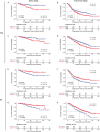The impact of preoperative immunonutritional status on prognosis in ovarian cancer: a multicenter real-world study
- PMID: 39962572
- PMCID: PMC11831797
- DOI: 10.1186/s13048-025-01607-4
The impact of preoperative immunonutritional status on prognosis in ovarian cancer: a multicenter real-world study
Abstract
Background: To investigate the effect of preoperative immunonutritional status on prognosis in epithelial ovarian cancer patients.
Methods: A multicenter real-world study included 922 patients with histologically confirmed epithelial ovarian cancer who received comprehensive staged surgery or debulking surgery at seven tertiary hospitals in China between 2012 and 2023. Prognostic nutritional index (PNI) and systemic immune-inflammation index (SII) were used to assess the immunonutritional status for their superior predictive power to indicate the nutritional status and the inflammatory immunity. Cox regression analyses were employed to identify variables associated with progression-free survival (PFS) and overall survival (OS).
Results: In the early-stage cohort of 224 epithelial ovarian cancer patients, the optimal cut-off value for PNI was 47.47 for both PFS and OS, while the optimal cut-off value for SII values were 551.37 for PFS and 771.78 for OS. In the late-stage group of 698 patients, the optimal PNI thresholds were 47.76 for PFS and 46.00 for OS, with SII values of 720.96 for PFS and 1686.11 for OS. In multivariate analysis of early-stage patients, high PNI was an independent protective factor for PFS (hazard ratio (HR), 0.39 (95% confidence interval (CI) 0.20-0.76), P = 0.006) and OS (HR, 0.44 (95% CI 0.20-0.97), P = 0.042), respectively. High SII was significantly associated with PFS (HR, 2.43 (95% CI 1.23-4.81), P = 0.011) and marginally unfavorable for OS (HR, 2.05 (95% CI 0.96-4.39), P = 0.064). In advanced population, PNI (HR, 0.77 (95% CI 0.60-0.99), P = 0.043) and SII (HR, 1.34 (95% CI 1.01-1.78), P = 0.041) were independent prognostic factors for OS but had no impact on PFS (P = 0.185, P = 0.188, respectively).
Conclusion: Poor preoperative immunonutritional status has a deleterious effect on the prognosis of patients with ovarian cancer. Intervention in patients suffering from suboptimal preoperative immunonutritional status may facilitate improved survival outcomes.
Keywords: Ovarian cancer; Overall survival; Preoperative immunonutritional status; Prognostic nutritional index; Progression-free survival; Systemic immune-inflammation index.
© 2025. The Author(s).
Conflict of interest statement
Declarations. Ethics approval and consent to participate: This study was approved by the Research Ethics Commission of Tongji Medical College of Huazhong University of Science and Technology (TJ-IRB202401053) in accordance with the Declaration of Helsinki. As a real-world retrospective study, the informed consent was waived, and the results were used for scientific research only. Consent for publication: Not applicable. Competing interests: The authors declare no competing interests.
Figures


References
-
- Bray F, Laversanne M, Sung H, Ferlay J, Siegel RL, Soerjomataram I, Jemal A. Global cancer statistics 2022: GLOBOCAN estimates of incidence and mortality worldwide for 36 cancers in 185 countries. CA Cancer J Clin. 2024;74:229–63. 10.3322/caac.21834. - PubMed
-
- Siegel RL, Giaquinto AN, Jemal A. Cancer statistics, 2024. CA Cancer J Clin. 2024;74:12–49. 10.3322/caac.21820. - PubMed
-
- Tyagi K, Mandal S, Roy A. Recent advancements in therapeutic targeting of the Warburg effect in refractory ovarian cancer: A promise towards disease remission. Biochim Biophys Acta. 2021;1876: 188563. 10.1016/j.bbcan.2021.188563. - PubMed
-
- Chien J, Poole EM. Ovarian Cancer Prevention, Screening, and Early Detection: Report From the 11th Biennial Ovarian Cancer Research Symposium. International journal of gynecological cancer : official journal of the International Gynecological Cancer Society. 2017;27:S20–2. 10.1097/igc.0000000000001118. - PMC - PubMed
-
- Hertlein L, Kirschenhofer A, Fürst S, Beer D, Göß C, Lenhard M, Friese K, Burges A, Rittler P. Malnutrition and clinical outcome in gynecologic patients. Eur J Obstet Gynecol Reprod Biol. 2014;174:137–40. 10.1016/j.ejogrb.2013.12.028. - PubMed
Publication types
MeSH terms
Grants and funding
LinkOut - more resources
Full Text Sources
Medical

